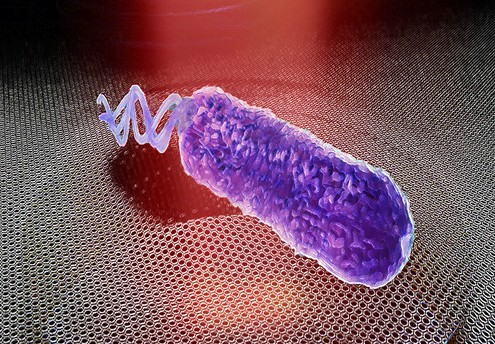Graphene ‘drums’ pick up vibrations from individual bacteria
24 May 2022 Isabelle Dumé

Ultrathin carbon sheets known as “graphene drums” can pick up vibrations created by the nanoscale movements of individual bacteria, giving researchers a sensitive new way of probing their behaviour. As well as advancing our understanding of the mechanobiology of bacterial cells, the technique might be used to screen the effectiveness of antibiotics in a rapid and simple way, say the researchers at TU Delft in the Netherlands who developed it.
Graphene – a sheet of carbon just one atom thick – has many unique properties, including high mechanical strength and exceptional electrical conductivity. It is also extremely sensitive to external forces, explains nanomechanical engineer Farbod Alijani, who led the research. When an object such as a bacterium sticks to the surface of a graphene drum – which is made from graphene sheets – it generates oscillations with amplitudes as small as nanometres. These oscillations can be detected using laser light.
In the case of bacteria, the oscillations predominantly come from the motion of flagella, which are tail-like structures on the microorganisms’ surface that help propel them through the aqueous environments in which they live. These flagella beat on the graphene drums with a force of up to 6 nN – around 10 billion times less than the force of a boxer’s punch on a bag, Alijani says. These beats can then be converted into “soundtracks” that researchers can monitor.
Detecting antibiotic resistance
The researchers performed their experiments in a cuvette containing live E. coli bacteria in a growth medium. They used laser light to determine how the bacteria deflected off the surface of the graphene drum. “The outcome of our first measurements was striking,” Alijani tells Physics World. “We were able to detect the babbles from individual bacteria.”
These “bacteria babbles” appeared as a noisy signal with a spectrum that suggested contribution from biological processes occurring at different times scales, with a major input from bacterial flagella, he says. This is the first time a technique has been shown to be capable of detecting the sound generated by a single bacterium in its aqueous growth environment.READ MORE

The technique could be used to detect antibiotic resistance, say the researchers. If the bacteria are resistant to an antibiotic, the oscillations would continue at the same level. If they were killed by the drug, however, the vibrations would decrease over a period of one or two hours before completely disappearing. This is fast compared to conventional antibiotic sensitivity tests that require at least 24-48 hours, explains Alijani. The graphene drums are also sensitive enough to detect such phenomena in just a single bacterium.
Alijani says the team is now optimizing its single-cell graphene antibiotic sensitivity platform to validate it against a variety of pathogenic samples, with the aim of bringing the technology closer to market. The research is detailed in Nature Nanotechnology.

Isabelle Dumé is a contributing editor to Physics World
from physicsworld.com 26/5/2022
Δεν υπάρχουν σχόλια:
Δημοσίευση σχολίου